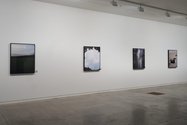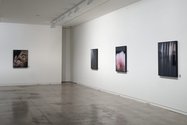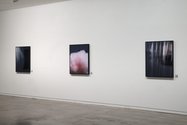John Hurrell – 20 June, 2021
Each of the ten photographs in As Far as the Eye can Reach is made with a pinhole camera so the image is fuzzy. Each is accompanied by a sound track of the artist reading descriptions of memorable places (or land/sky forms) written by blind or sight-impaired people. These texts (each with a QR code so they can be accessed in audio form by gallery visitors' smart phones) have guided the artist in her creation of imagery, and are also written in braille embossed onto a rectangle of clear film placed in each work's centre.
Examining the relationship between language and the imagery that generates it is a well known theme that never seems to become exhausted. Both Sophie Calle and Sol LeWitt, for example, have made works that pair off verbal description (one from a blind person describing a memory so that the visual component could be created or discovered by the artist, the other where the artist describes in detail a drawing he wants to create and gives those instructions to an assistant) with image—inevitably evoking comparisons and showcasing discrepancies.
Conor Clarke‘s show has a clever title because it suggests that the eye is like an extended arm, and has physical limitations. It also allows ‘reach’ to be mistakenly seen as ‘read’, hinting also that optical sensation is language-based and embedded in interpretation.
Each of the ten photographs in As Far as the Eye can Reach is made with a pinhole camera so the image is fuzzy. Each is accompanied by a sound track of the artist reading descriptions of memorable places (or land/sky forms) written by blind or sight-impaired people. These texts (each with a QR code so they can be accessed in audio form by gallery visitors’ smart phones) have guided the artist in her creation of imagery, and are also written in braille embossed onto a rectangle of clear film placed in each work’s centre. They vary greatly in length, and as you’d expect, reference mainly the senses of sound, smell, temperature and touch.
One might wonder why the writers themselves didn’t read their own writing, but it takes skill to read aloud fluently (whether you are blind or sighted) and perhaps the blind authors felt that would be an intrusion. However the reading by the artist is another form of interpretation. It seems to be an element of mediation unnecessarily added. Diverse ‘authentic’ voices would have created a nice tension, presenting a sonic foil to the suite of ten same sized pinhole images.
As you can probably see, the work is in essence a club sandwich of pinhole image, spoken text and braille tactility (albeit translated by a few). The layers can’t really be peeled off and separated, because at least three senses are crucial for an understanding of what is on offer. Experiencing only one of those sensory presentations is merely a part of it—and misses the point. Two of them is pretty good (certainly an improvememt), but all three (including fingertips) are necessary if one is to mentally move closer to the complex mingling of the senses for which the artist is striving.
John Hurrell














 Advertising in this column
Advertising in this column Two Rooms presents a program of residencies and projects
Two Rooms presents a program of residencies and projects



This Discussion has 0 comments.
Comment
Participate
Register to Participate.
Sign in
Sign in to an existing account.